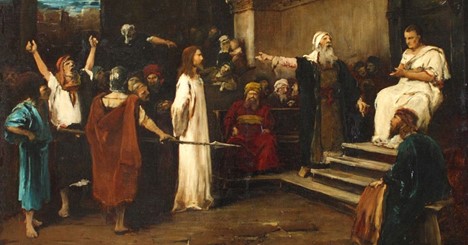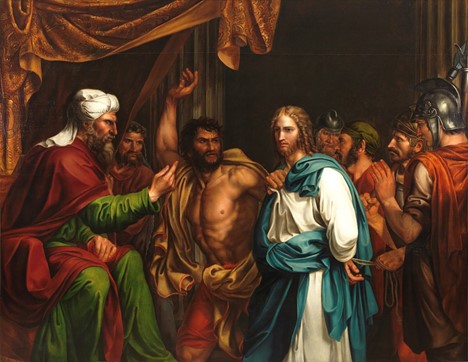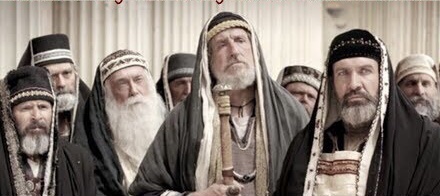As we draw near to the annual celebration of Easter, we find that we have a story that is driven by antagonism and conflict, with scenes of aggression and violence. We need to think carefully about how we tell the story found in the Gospels, and reflect prayerfully about how we preach the good news from these narratives.
We know the main characters in the story: Jesus and his followers, and the key authority figures of his day, lined up against him: the Jewish Sanhedrin; Pontius Pilate, the Roman Governor of Judea; and Herod Antipas, tetrarch of Galilee and Perea.
The way that the story unfolds, invites those who hear it—and those who preach on it—to make one party into “the villain”, even as others in the story receive (implicit) excusing. We side with Jesus, and that makes us view the other characters as “the baddies”.
So the danger sits before us, at Easter most especially: we might be tempted to target “the Jews”, to make negative or derogatory comments about Judaism and Jewish people, even (although I would hope not) to blame “the Jews” for the death of the Messiah. How close does this come to anti-Judaism, or even antisemitism?
We can be helped in our task by careful reflection on the nature of the texts, which we read, hear, explain, and reflect on, as we approach Easter, and especially as we move through Holy Week, from Passion Sunday to Good Friday.
Of the three key characters—the Jewish Sanhedrin, the Governor Pilate, and the tetrarch Herod Antipas—Herod has a somewhat tangential role: he appears only in Luke’s story (Luke 23:6-12) and simply rubber-stamps the decision of Pilate. Despite what Luke claims, there is no historical evidence that provides any reason why Jesus had to be presented to Herod, so the historicity of this scene is highly dubious.

The Roman Governor, Pontus Pilate, is given a very big “exemption pass” in the Gospel narratives. In the earliest account, he questions the crowd as to whether he should sentence Jesus (Mark 15:5, 14). The same question is noted in Matt 27:23. By the time of Luke’s Gospel, there is a clear threefold affirmation of the innocence of Jesus (Luke 23:4, 13-16, 22).
By the fourth Gospel, the scene where Jesus is brought to Pilate is changed from a trial to a philosophical discussion (John 18:29-31, 38). He and (quite uncharacteristically) backs down in the face of a baying crowd (Mark 15:6-15, and parallels). In Matthew’s account, Pilate enacts the potent symbol of washing his hands of the whole affair (Matt 27:24).
The Jewish Sanhedrin, by contrast, is placed firmly in the firing line. All four Gospels tell the story in the same way: the central factor that leads to Jesus being condemned to death is the decision of the Jewish Sanhedrin (Mark 14:63-64, and parallels), and their agitation amongst the crowd (Mark 15:11; Matt 27:20; Luke 23:13-16; John 18:38b-40).

Jesus about to be struck in front of former High Priest Annas
(Madrazo, 1803)
Matthew intensifies this by reporting that “the people as a whole answered, ‘His blood be on us and on our children!’ (Matt 27:25). John’s Gospel reports that “the Jews cried out, ‘If you release this man, you are no friend of the emperor. Everyone who claims to be a king sets himself against the emperor.’” (John 19:12), reinforced by the later statement by the chief priests, “we have no king but the emperor” (John 19:15).
This telling of the story is, in my view, a rhetorical strategy which is employed by all four evangelists. It may well have been a common stance across the early church. The central problematic for the earliest followers of Jesus must have been that their leader, Jesus of Nazareth, was crucified by the Romans, who held great power at the time.
Crucifixion was a Roman punishment, and Jesus was crucified as a political rebel, on the basis of the notion that he was claiming to be “King of the Jews”. The phrase recurs as a regular refrain throughout all four accounts of the crucifixion (Mark 15:2,9,12,18,26; Matt 27:11,28-29,37,42; Luke 23:2-3,37-38; John 18:33,37,39; 19:3,12,14,15,19-22).
To identify as a follower of Jesus would be to stand in solidarity with him as a rebel, an unwanted criminal who was rightly (in Roman eyes) punished with death. That would be a very dangerous (and foolish!) place to want to stand. So a different strategy was required.
At the same time as the early church was considering how to continue living without being seen as a rebellious movement in the Roman Empire, a slow and growing struggle for this movement was taking place—first in some places, then spreading to many other places. The struggle was with the leadership of the local synagogue.
The Pharisees, in the decades after the destruction of the Temple in 70 CE, had been gaining a dominant position amongst Jews of the time. The tensions between the followers of Jesus and the Pharisees grew and developed over time. The way the Gospels report on the interactions between Jesus and the Pharisees reflects the intensification of this relationship.

So, the Pharisees placed demands on the followers of Jesus, especially when made claims that Jesus was the Messiah. The earliest followers were all Jews, and they remained the dominant group in the movement for some decades. The followers of Jesus became increasingly discontented with their lives in the Jewish community, under the rule of the Pharisees. Accusations grew; tensions increased; conflict burst out into the open.
So, in retelling the story of how Jesus met his end, the followers of Jesus began, not only to downplay the role played by the Roman Governor (a very practical strategy, to be sure!), but also to increase the culpability of the Jewish authorities. And so grew the narrative of the last days, the arrest, trial, and sentencing of Jesus, that we are familiar with from the Gospels in the Bible.
The trap we must avoid, then, is this: do not read the Gospel narratives as straightforward, unadorned historical narratives. Do not accept “at face value” all that is recorded in those chapters. Apply careful, reasoned criticism as you approach the text. Consider the narrative of the passion, not only in its literary context, but in the context of the religious, social and political streams that were swirling in the later first century.
And invite those who reflect with you, or listen to your words, or read the stories in the text, to do the same—not to blame “the Jews” for what happened to Jesus; but rather, to consider how the story may well have been shaped, over the decades, in the face of the pressures and stresses of life for the early followers of Jesus, in the Roman Empire, with growing antagonism from (and towards) the Jewish authorities.
This is certainly quite consistent with the policy adopted by the Uniting Church National Assembly in 2009, which declares that “The Uniting Church acknowledges with repentance a history of interpretation of New Testament texts which has often failed to appreciate the context from which these texts emerged, viz. the growing separation of Christianity and Judaism with attendant bitterness and antagonism, resulting in deeply rooted anti-Jewish misunderstandings” (para. 9).
The Statement on Jews and Judaism also affirms that “The Uniting Church does not accept Christian teaching that is derogatory towards Jews and Judaism” (para. 16). We need to hold to this in what we preach at Easter.
Rev Dr John Squires is Presbytery Minister (Wellbeing) for Canberra Region Presbytery. This reflection originally appeared on his blog, An Informed Faith.











